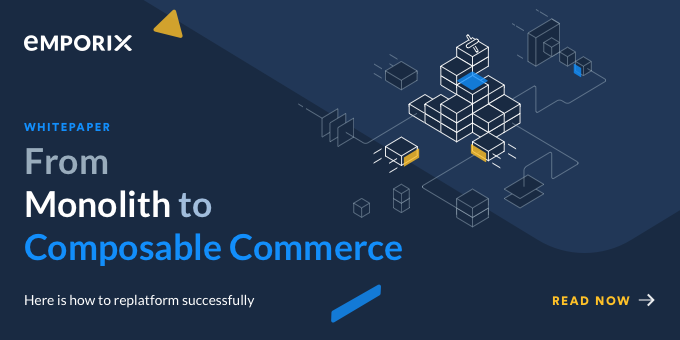B2B grocery: Time for suppliers to evolve their digital commerce
Like most other commercial sectors, the grocery market is evolving. While manufacturers and CPG (consumer packaged goods) suppliers will no doubt continue to deal with large supermarkets and retail outlets, new opportunities are also emerging in the form of smaller chains and independent stores. These smaller grocery outlets have even experienced a small lift in trade during the pandemic, driving nearly a third of all grocery sales according to some estimates.
Supermarkets aren’t going anywhere, but if manufacturers and CPG suppliers want to maximize their reach, now is the perfect time to start thinking about how to cater to smaller chains and independent grocers. And thanks to new digital commerce technology, it couldn’t be easier.
The goal of a grocery manufacturer or supplier will always be to get food products onto supermarket shelves. It’s where the bulk of profit will be made and it’s a surefire way to get the best possible distribution for a range of products.
Getting products into supermarkets usually means playing by their rules, using their digital services to take and fulfill orders, so manufacturers have never really had any need to think about their own digital commerce infrastructure. But if they want to take advantage of a diversifying grocery market, as well as continue to supply the big supermarket chains, they’re going to need to think about digitalizing their processes.
Doing so will not only allow them to deal with small, independent traders, but also help to streamline their internal processes, and even open the door to new channels such as direct-to-consumer (D2C).
Broadening reach and appeal in a diversifying grocery market
Suppliers and manufacturers will carry on doing business with large supermarkets and retail outlets long into the future, effectively leaning on their customers’ digital commerce platforms to receive and fulfill orders. But even if that continues to account for 80% of a manufacturer’s business, what about the other 20%?
If a manufacturer doesn’t have its own digital commerce capabilities, it has to lean on traditional methods like phone calls, emails and written orders to nurture that 20% and include it as part of its revenue stream. This is problematic for two reasons.
The first reason is to do with the audience. According to research by Forrester, the B2B buying process is now dominated by millennials, with 73% of all those involved in making purchasing decisions aged between 26 and 40. This is as true in the grocery sector as any other B2B environment, and older generations might have been comfortable with sales literature and manually written orders, today’s buyer expects a more streamlined, digitized process, and that extends to consumers too. That might include the ability to ‘self serve’ on a website, or receive timely reminders, tailored deals or product recommendations.
The second reason is to do with the unique nature of the grocery sector itself. We know that B2B retail, in general, is becoming more customer-centric, borrowing trends from consumer-facing commerce like apps, delivery notifications and other conveniences.
But the grocery sector still very much has its own identity when it comes to supply and distribution that make most ‘out-of-the-box’ commerce platforms unfit for purpose. Rather than just delivering ‘X’ number of items, suppliers need to be able to cater to differences in weight and even food preferences. If a manufacturer wants to forge some channel partnerships, for instance, those partners will need to cater to customers that have very specific preferences on everything from how ripe their bananas are to which cut of meat they buy.
Everything mentioned above would ordinarily be taken care of by large supermarket chains themselves, so it’s never something manufacturers have to concern themselves with. But if they want to broaden their reach, they’ll need to invest in technology that allows them to cater to these kinds of needs independently when opportunities arise. Thankfully, it’s very easy to set up with the right kind of technology partnership.
Why digital transformation is nothing to fear
For manufacturers and suppliers, digital transformation means independence. By digitalizing the order and fulfillment process, they’re able to cater to a broader range of grocers without any limitations. While digital transformation might seem intimidating at first, fully-customizable B2B grocery commerce platforms have made the transition incredibly painless, and they can be seamlessly integrated with existing product information management (PIM) and enterprise resource planning (ERP) tools.
Take Emporix’s B2B Composable Commerce platform, for instance. With it, manufacturers and suppliers can become fully independent operators, able to cater to even the smallest grocers with their own digital tools that not only improve the buying experience for the customer but make life easier for staff.
Customers will be able to enjoy a seamless purchasing experience, able to order their goods by item, weight, or other personalized criteria; while staff will be able to move away from time-consuming manual processes like making sales calls, taking orders over the phone, or writing up invoices. Becoming ‘digitally independent’ doesn’t mean manufacturers will be replacing their current partnerships with big supermarkets, just opening the door to new partnerships at the same time.
Grocery is evolving, and if manufacturers and CPG suppliers want to take advantage of that evolution and broaden their revenue streams, now is the perfect time to start thinking about their own digital commerce presence. To learn more about Emporix’s B2B Composable Commerce platform or speak to one of our grocery B2B specialists, get in touch today.

